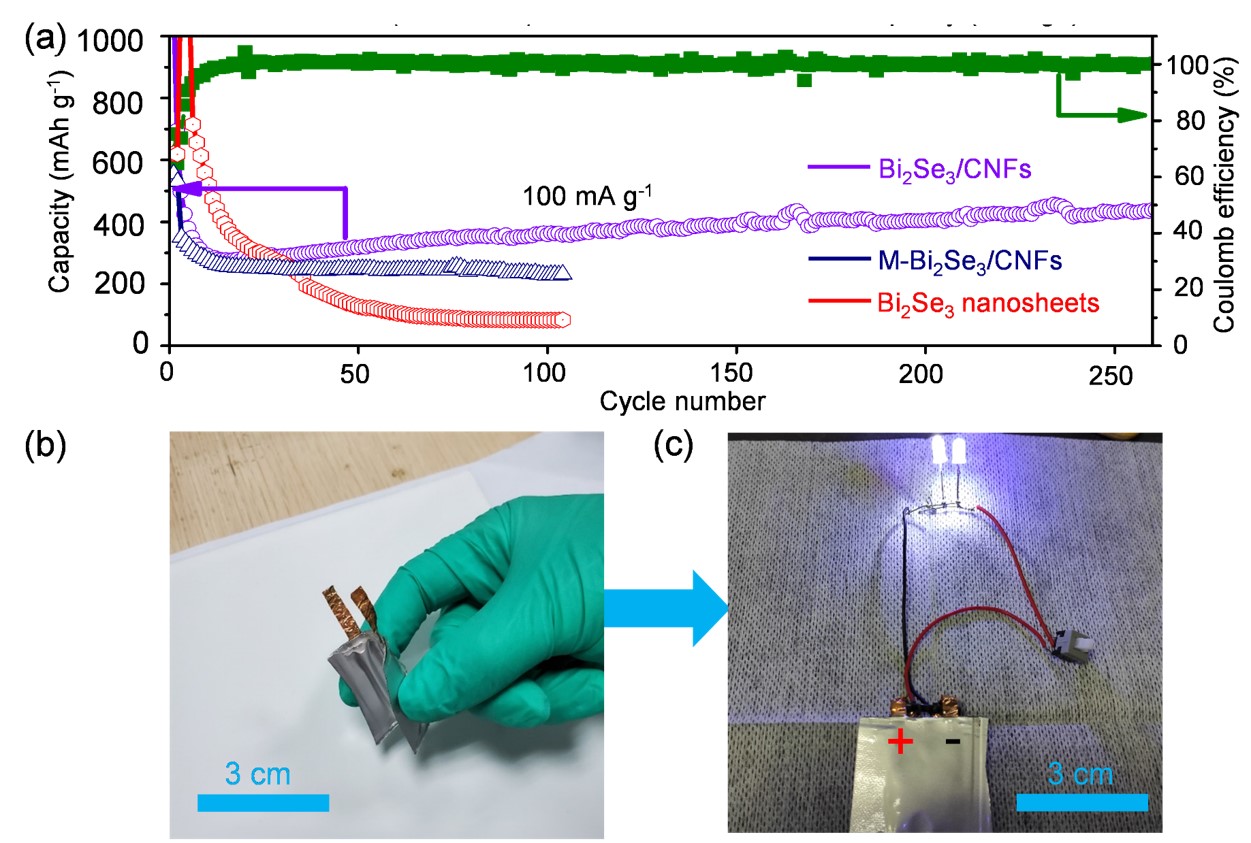The rapid development of portable electronic devices and electric vehicles has put forward a huge demand for advanced lithium-ion batteries.The V-VI metal compound Bi2Se3has the advantages of high theoretical specific capacity, lamellar structure easy for lithium and delithium, abundant raw materials,low price and facile preparation, and so on. It is a potential high-performance anode material.However, its low electronic conductivity and ion diffusion lead to poor electrochemical activity during charge and discharge, and serious degradation of the capacity and cycle life, which seriously hinders the application of V-VI compounds in anode materials.

Figure 1. SEM, TEM, HR-TEM, SAED pattern, elemental mapping images of Bi2Se3/CNFs.
Recently, Li et al. from Wuhan National Laboratory of Optoelectronics, Huazhong University of Science and Technology used electrospinning combined with selenization in vacuum tube to prepare a self-standing three-dimensional network structureBi2Se3/CNFsof Bi2Se3nanoparticles (about 40 nm) embedded in carbon nanofibers (CNFs) successfully (Figure1). Thisspecialstructure can not only provide countless active sites, but also the three-dimensional carbon nanofiber gaps are conducive to electrolyte infiltration and improve lithium ion diffusion efficiency.

Figure 2.(a) Cycling performance of the Bi2Se3/CNFs, M- Bi2Se3/CNFs and Bi2Se3nanosheets at a current density of 100 mA g-1; (b)Thephotographofflexible full batteryofLiCoO2vs. Bi2Se3/CNFs; (c) The photograph of lighting two LEDs (3.7 V, 1 W) by the full-cell composed of LiCoO2and Bi2Se3/CNFs.
ComparedwithM-Bi2Se3/CNFs (mashed Bi2Se3/CNFs) and Bi2Se3nanosheets which both need binder and conductive additives when used as a anode,self-standing Bi2Se3/CNFs exhibits superior electrochemical performanceasaanode forlithium-ion batteries.After 260 cycles at a current density of 100 mA g-1from 0.01 to 3.0 V, there is still a specific capacity of 443 mAh g-1which even keep growing up slowly.The full-cell assembled with flexibleBi2Se3/CNFsandLiCoO2could still light LEDs (3.7 V, 1W) after10timesfolding to 90 degrees (Figure 2). Tthis work provides a new material design idea for the application of V-VI metal compounds in high energy density lithium-ion batteries.
The above related results were published on Materials Chemistry Frontiers, and the project was co-funded by the National Natural Science Foundation of China and the basic scientific research business fees of central universities.
The authors of the paper are Hongqing Qu (first author), Hong Yin, Yalong Wang, Cheng Fan, Kwun Nam Hui, Chong Li (corresponding author), Mingqiang Zhu.
Title:Vapor selenization produced Bi2Se3nanoparticles in carbon fiber 3D network as binder-free anode for flexible lithium-ion batteries
The full text link:https://doi.org/10.1039/D0QM00884B.